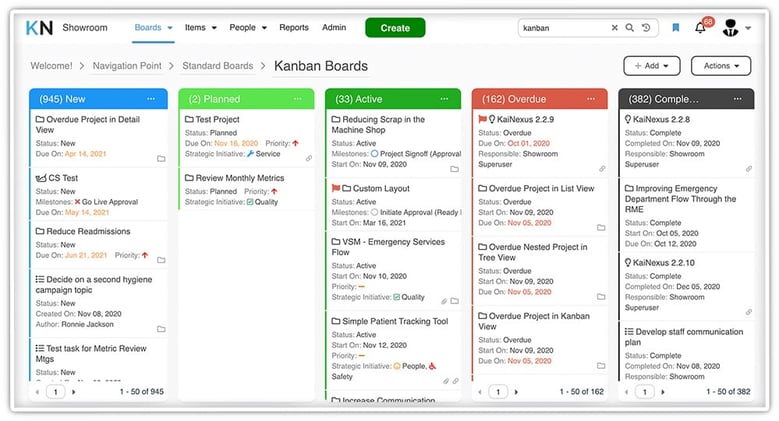If you’ve watched our recent webinar, Taking Improvement Boards Digital: How Leading Companies are Improving Visual Management, or been reading our posts about the same, you would have heard the term “Kanban board” used. While it’s great to hear that KaiNexus software supports digital Kanban boards, it’s even better if you have a clear understanding what a Kanban board is, and how it can help you on your continuous improvement journey. Here’s the rundown:
What is Kanban?
We’ve written a longer primer on Kanban here, but the important thing to know is that it is a visual system for monitoring the flow of work from the start, as we build a backlog, move work into in-process (while hopefully limiting WIP), and complete this work.
Visualization works so well because our brains interpret visual information far faster than data or text. By reducing complex material down to visual components and putting them together, managers and staff can get an overview of the whole workflow system in seconds rather than the hours it might take to track down information in every area, work through it, and synthesize it down into conclusions that can be shared.
The term Kanban literally translates from Japanese to mean “signboard” or “visual signal," so one of the key components of Kanban is, of course, visualization, which is why Kanban boards are really the heart of Kanban in modern use.
Listen to this Post and Subscribe to the Podcast:
What does a Kanban board look like?
Back in the 1940s and 50s the system that first had the name Kanban consisted of “Kanban Cards,” each representing a needed product. As parts were consumed or shipped, and when certain planned inventory levels were reached, a Kanban card would usually be physically sent to the manufacturing process that would replenish the supply. The cards might be put on a board where they were sequenced and prioritized for production and replenishment.
This type of visualization is invaluable in spotting imbalances in demand with available capacity and bottlenecks. By working to eliminate bottlenecks and improve flow, organizations can reduce costs, improve quality, and speed up the fulfillment of supply to customers.
The goal of Kanban is to help the work flow smoothly so that each area of the system the work is flowing through has the capacity to complete the work so that it reaches the next area "just in time," preventing a logjam.
In modern times, Kanban cards are still used in factories (and hospitals) to trigger the production or replenishment of supplies, helping manage the flow of the system. But, the Kanban method has been adapted for use in planning construction, software projects, improvement projects, or one's own work (see the book Personal Kanban).
Items to be done are listed on sticky notes or cards, and they are then placed on a board that usually has three to five columns, depending on how it's set up.
A key principle of Kanban, beyond visualizing our work, is to also limit our WIP (Work in Progress). An overloaded system and bottlenecks are very easy to see on a Kanban board because some columns will have too many items while others may not have enough.

More complex processes can combine vertical columns and horizontal rows. A Kanban board can, and should, be completely unique and tailored to the workflow of the process and team it’s used for.
Can they also be used in service industries?
Yes! Just like a product can be moved through a manufacturing system, your customers—or patients, or clients, or constituents, etc—can move through your service workflow.
If you have steps in your workflow, a Kanban board can help you visualize it and optimize it.
Can I put my improvements into Kanban boards?
Yes! Kanban boards are the perfect way to give executives, managers, and staff a visual overview of improvement efforts in your organizations. In fact, an up-to-date Kanban board detailing an organization’s improvement efforts can quickly become a keystone for building a culture of continuous improvement.
Why would we want our Kanban board to be digital?
If your team is small, located in one space, and work at the same times, a paper Kanban board using post-its or notecards may be very effective. Once you have workflows that reach across large teams, across multiple teams, in multiple spaces, and at various different times – think night shift employees—however, digital boards make things much simpler.
As with any digital upgrade, taking your Kanban boards digital saves time and rework as they are automatically updated as other parts of the system are updated. Improvements and projects automatically flow through the charts based on their current status.
Even better, when you see a problem, you can begin to drill down to the find the cause (and the solution) with the click of a button. Email integration, real-time updates for remote workers and stakeholders, and integration with other software systems are also benefits of going digital.
To see what a digital Kanban board might look like for your organization, and to get more information on how it can be used to help your continuous improvement efforts, I suggest booking a custom demo.



Add a Comment